When cybersecurity experts speak about a cyber attack, they often refer to actions taken “left of boom” and “right of boom.”
In this analogy, the boom is the breach, and the actions organizations take in the aftermath, such as utilizing their incident response plan or working with their cyber insurance company on a claim, are what happens “right of boom.” But it’s the things that happen “left of boom” that can make the difference between proactive and reactive protection.
In the modern cybersecurity threat landscape, global experts are coming to a simple consensus: A strong security posture involves both proactive preparation in case of attack and robust response should one occur.
In Incident Readiness: Improving Your Cyber Attack Response — a new issue brief from the Center for Digital Government with input and information from Arctic Wolf® — readers will discover how public agency leaders can manage risks and limit the damage of cyber attacks through this sort of two-pronged protection.
How to Improve Your Cyber Attack Response
Prepare To Be Attacked
Effective cyber hygiene includes monitoring networks and devices, flagging intrusions, and trying to halt the spread of malware. But threat actors inevitably circumvent these defenses, so you must be poised to act.
Effective incident response is a balancing act — finding the quickest path forward while avoiding hasty decisions that might trigger cascades of problems. There’s no substitute for working out a plan and proving it works. Here are a few steps the Center for Digital Government outlines in the report.
Formulate a Strategy
Strategies help leaders navigate the early stages of incident response. A formal response strategy includes the people who guide the response, the processes to implement and the technologies to be deployed. A strategy should identify the severity of the threat and establish priorities depending on the scope of the attack’s impact.
Identify Stakeholders
Response planning requires naming the people most critical to implementing your strategy. In-house stakeholders include agency executives and technology leaders.
Conduct Tabletop Exercises
Gather your response team and walk them through their cyber attack responsibilities. Throw them a few curveballs to cover outlier scenarios. The goal is to create the worst possible day for your response team and help them discover how to adapt to roadblocks, hurdles, and impediments.
Respond Robustly Both During and After
Containing the impact of a cyber attack is only the start. You must learn why it happened and strengthen your defense against future incidents. The report outlines a concise, four-point framework which will help any response team respond, rebuild and guard against future attacks. Here are the first two steps of the framework:
Chart Your First Moves
Threat actors are always probing networks for weaknesses and triggering alerts in detection-and-response systems. You must distinguish between these activities and a genuine crisis that affects essential agency systems. While you have no time to waste in cyber response, you cannot afford to rush into ill-considered decisions.
Convene the Cyber Response Team
Get all your stakeholders together and make sure they know their responsibilities from the response strategy. Make sure the technical and non-technical people understand what’s at stake and the nature of the threat.
Incident Readiness: Improving Your Cyber Attack Response dives deeper into these topics, as well as five more, offering security leaders a robust list of action items they can put into practice today to improve their incident response plan and harden their security posture.






